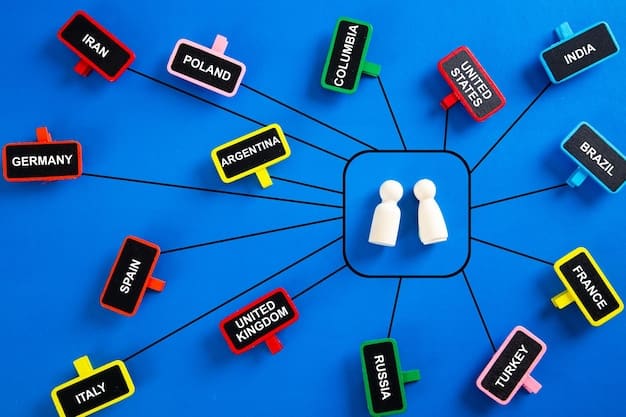Master the Art of Persuasion: Ethical Influence for Success

The art of persuasion involves ethically influencing others by understanding their needs and values, building rapport, and presenting ideas compellingly. By mastering these skills, individuals can achieve their goals while maintaining integrity in their interactions.
Do you aspire to inspire change, advocate for your ideas, or simply connect more effectively with the people around you? Mastering the art of persuasion is not about manipulation, but about understanding human psychology and communicating your message in a way that resonates ethically and helps you achieve your goals. This guide will explore how to ethically influence others and build stronger relationships.
Understanding the Foundations of Persuasion
Persuasion is a fundamental aspect of human interaction. Whether you’re negotiating a deal, presenting an idea, or simply trying to get your point across, understanding the principles of persuasion can significantly enhance your effectiveness. However, it’s crucial to approach persuasion ethically, ensuring that your methods are honest, respectful, and beneficial to all parties involved.
The Importance of Ethical Persuasion
Ethical persuasion emphasizes transparency, integrity, and mutual benefit. It’s not about tricking or coercing someone into doing something they don’t want to do. Instead, it’s about understanding their needs, values, and motivations, and presenting your ideas in a way that aligns with their interests.
- Builds Trust: Ethical persuasion fosters trust and credibility, essential for long-term relationships.
- Respects Autonomy: It respects the other person’s right to make informed decisions without pressure or manipulation.
- Promotes Collaboration: It encourages collaboration and mutual understanding, leading to more positive outcomes.
By adopting an ethical approach, you not only achieve your immediate goals but also cultivate a reputation as a reliable and trustworthy individual, which is invaluable in personal and professional contexts. Ethical persuasion ensures that your influence is positive and sustainable.
The Psychology Behind Persuasion
To become a truly effective persuader, it’s essential to understand the underlying psychological principles that influence decision-making. By knowing how people’s minds work, you can tailor your approach to resonate with them more effectively. Here are some key psychological concepts.

Key Psychological Concepts in Persuasion
Several psychological biases and principles play a crucial role in persuasion. Understanding these can help you anticipate how people might react and adjust your approach accordingly.
- Reciprocity: People tend to return favors or gestures. If you do something nice for someone, they’re more likely to reciprocate.
- Scarcity: Items or opportunities that are limited in availability are perceived as more valuable. Highlighting scarcity can create a sense of urgency.
- Authority: People are more likely to be influenced by individuals they perceive as knowledgeable or authoritative.
Understanding these concepts will allow you to fine-tune your persuasive strategies and become more effective at guiding others towards mutually beneficial outcomes. Ethical and informed persuasion enhances your communication skills and fosters stronger relationships.
Building Rapport and Trust
Before you can effectively persuade someone, you need to establish rapport and trust. People are more likely to be receptive to your ideas if they feel a connection with you and believe that you have their best interests at heart. Building rapport involves creating a positive and comfortable atmosphere.
Techniques for Building Rapport
Building rapport is not just about being friendly; it’s about creating a genuine connection with the other person. Several techniques can help you establish a strong foundation of trust and understanding.
Active listening is fundamental. Pay close attention to what the other person is saying, both verbally and nonverbally. Show genuine interest in their thoughts and feelings. Mirroring is another powerful tool. Subtly matching the other person’s body language, tone, and language style can create a sense of rapport.
Showing empathy is also essential. Try to understand the other person’s perspective and acknowledge their feelings. This demonstrates that you care about their well-being and are not just focused on your own agenda. By consistently employing these techniques, you can foster stronger, more trusting relationships that are conducive to ethical persuasion.
Communication Skills for Effective Persuasion
Effective communication is the cornerstone of persuasive power. It’s not just about what you say, but how you say it. Mastering various communication skills can significantly enhance your ability to influence others ethically and achieve your goals. This section will delve into critical communication techniques.
Verbal and Non-Verbal Communication
Both verbal and non-verbal cues play vital roles in the art of persuasion. Your choice of words, tone of voice, and body language all contribute to the overall impact of your message.
- Clarity and Conciseness: Speak clearly and get straight to the point. Avoid technical jargon and complicated sentence structures.
- Confident Tone: Project confidence in your voice. A strong and steady tone can convey expertise and trustworthiness.
- Positive Body Language: Maintain eye contact, smile, and use open and welcoming gestures. Avoid crossing your arms or fidgeting.
Combining effective verbal and non-verbal communication techniques can amplify your persuasive abilities. By being mindful of these elements, you can ensure that your message is not only heard but also resonates deeply with your audience, leading to more successful and ethical persuasion.
Crafting Persuasive Arguments

Developing well-reasoned and compelling arguments is crucial for persuading others. It’s not enough to simply state your opinion; you need to provide evidence, logic, and emotional appeals that support your claims.
When structuring your argument, start with a clear and concise statement of your position. Next, present your supporting evidence. This could include facts, statistics, examples, and expert opinions. Ensure that your evidence is credible and relevant to your argument. Third, address potential counterarguments. Anticipate the objections that someone might raise and provide reasoned responses.
Crafting persuasive arguments involves understanding your audience, presenting solid evidence, and addressing counterarguments. These elements effectively appeal to both logic and emotion.
The Power of Storytelling in Persuasion
Humans are naturally drawn to stories. We remember them more easily than facts or statistics, and they have the power to evoke emotions and create connections. Incorporating storytelling into your persuasive strategies can make your message more memorable and impactful.
Elements of a Persuasive Story
A persuasive story should have several key elements. Start with a relatable character or scenario. People are more likely to be persuaded by stories that they can connect with on a personal level. Next, introduce a problem or challenge. This creates tension and draws the audience in. Then, present your solution or idea as the resolution to the problem.
A persuasive narrative connects with listeners emotionally, making your message resonate more profoundly and boosting its lasting effect. Weaving these elements together ensures that your message leaves a lasting impression. By harnessing the power of storytelling, you can transform your message from a simple argument into a compelling narrative.
Maintaining Ethics in Persuasion
Maintaining ethical standards is paramount in the art of persuasion. Persuasion should never involve deception, manipulation, or coercion. Always ensure that your persuasive efforts are grounded in honesty, transparency, and respect for the other person’s autonomy. Ethical practices ensure that you are building trust and maintaining your integrity.
- Transparency: Be open and honest about your intentions. Disclose any potential biases or conflicts of interest.
- Respect: Treat others with respect, even if you disagree with their views. Avoid personal attacks or demeaning language.
- Fairness: Ensure that your persuasive efforts are fair and just. Avoid exploiting vulnerabilities or taking advantage of others.
When you persuade ethically, you foster genuine connections and enhance your reputation as a trustworthy individual. This strengthens your capacity to influence others positively and attain long-term achievements.
| Key Element | Brief Description |
|---|---|
| 🤝 Building Rapport | Creating a connection through active listening and empathy. |
| 🗣️ Communication | Using verbal and non-verbal cues effectively. |
| 📚 Crafting Arguments | Presenting evidence and addressing counterarguments. |
| 🌟 Ethical Persuasion | Maintaining honesty, transparency, and respect. |
[Frequently Asked Questions]
▼
Persuasion involves ethically influencing others through clear communication and mutual respect. Manipulation, on the other hand, uses deceit and coercion to achieve a selfish goal, often disregarding the other person’s feelings.
▼
Building trust involves active listening, showing empathy, and demonstrating integrity. Be honest and transparent in your communication, and always respect the other person’s perspective, even when you disagree.
▼
Non-verbal communication is crucial for persuasion. Your body language, tone of voice, and facial expressions can either reinforce or undermine your message. Maintain eye contact, smile, and stay confident to convey credibility.
▼
Handle objections by anticipating them and preparing thoughtful responses. Listen carefully to the concerns, acknowledge their validity, and provide evidence or explanations that address those concerns in a respectful manner.
▼
Ethical persuasion builds long-term trust and respect. It fosters stronger relationships and ensures that your influence is positive and sustainable. Unethical practices damage credibility and can lead to negative consequences.
Conclusion
Mastering the art of persuasion involves a blend of understanding human psychology, honing your communication skills, crafting compelling arguments, and always maintaining ethical standards. By focusing on building trust, respecting autonomy, and ensuring mutual benefit, you can ethically influence others and achieve your goals while fostering positive and lasting relationships.





